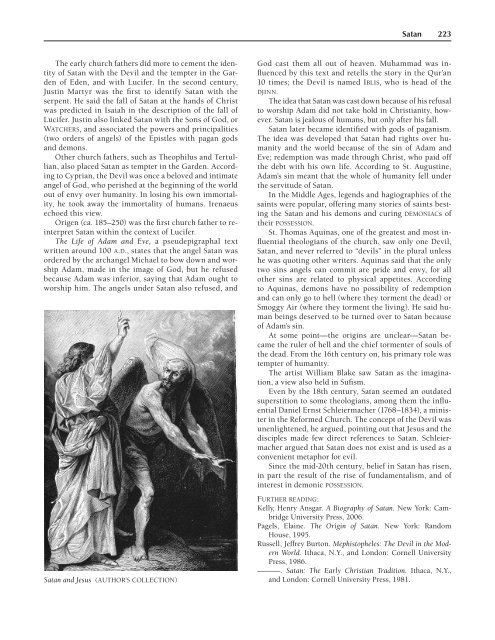The Encyclopedia Of Demons And Demonology
The Encyclopedia Of Demons And Demonology
The Encyclopedia Of Demons And Demonology
You also want an ePaper? Increase the reach of your titles
YUMPU automatically turns print PDFs into web optimized ePapers that Google loves.
Satan 223<br />
<strong>The</strong> early church fathers did more to cement the identity<br />
of Satan with the Devil and the tempter in the Garden<br />
of Eden, and with Lucifer. In the second century,<br />
Justin Martyr was the first to identify Satan with the<br />
serpent. He said the fall of Satan at the hands of Christ<br />
was predicted in Isaiah in the description of the fall of<br />
Lucifer. Justin also linked Satan with the Sons of God, or<br />
WATCHERS, and associated the powers and principalities<br />
(two orders of angels) of the Epistles with pagan gods<br />
and demons.<br />
Other church fathers, such as <strong>The</strong>ophilus and Tertullian,<br />
also placed Satan as tempter in the Garden. According<br />
to Cyprian, the Devil was once a beloved and intimate<br />
angel of God, who perished at the beginning of the world<br />
out of envy over humanity. In losing his own immortality,<br />
he took away the immortality of humans. Irenaeus<br />
echoed this view.<br />
Origen (ca. 185–250) was the first church father to reinterpret<br />
Satan within the context of Lucifer.<br />
<strong>The</strong> Life of Adam and Eve, a pseudepigraphal text<br />
written around 100 A.D., states that the angel Satan was<br />
ordered by the archangel Michael to bow down and worship<br />
Adam, made in the image of God, but he refused<br />
because Adam was inferior, saying that Adam ought to<br />
worship him. <strong>The</strong> angels under Satan also refused, and<br />
Satan and Jesus (AUTHOR’S COLLECTION)<br />
God cast them all out of heaven. Muhammad was influenced<br />
by this text and retells the story in the Qur’an<br />
10 times; the Devil is named IBLIS, who is head of the<br />
DJINN.<br />
<strong>The</strong> idea that Satan was cast down because of his refusal<br />
to worship Adam did not take hold in Christianity, however.<br />
Satan is jealous of humans, but only after his fall.<br />
Satan later became identified with gods of paganism.<br />
<strong>The</strong> idea was developed that Satan had rights over humanity<br />
and the world because of the sin of Adam and<br />
Eve; redemption was made through Christ, who paid off<br />
the debt with his own life. According to St. Augustine,<br />
Adam’s sin meant that the whole of humanity fell under<br />
the servitude of Satan.<br />
In the Middle Ages, legends and hagiographies of the<br />
saints were popular, offering many stories of saints besting<br />
the Satan and his demons and curing DEMONIACs of<br />
their POSSESSION.<br />
St. Thomas Aquinas, one of the greatest and most influential<br />
theologians of the church, saw only one Devil,<br />
Satan, and never referred to “devils” in the plural unless<br />
he was quoting other writers. Aquinas said that the only<br />
two sins angels can commit are pride and envy, for all<br />
other sins are related to physical appetites. According<br />
to Aquinas, demons have no possibility of redemption<br />
and can only go to hell (where they torment the dead) or<br />
Smoggy Air (where they torment the living). He said human<br />
beings deserved to be turned over to Satan because<br />
of Adam’s sin.<br />
At some point—the origins are unclear—Satan became<br />
the ruler of hell and the chief tormenter of souls of<br />
the dead. From the 16th century on, his primary role was<br />
tempter of humanity.<br />
<strong>The</strong> artist William Blake saw Satan as the imagination,<br />
a view also held in Sufism.<br />
Even by the 18th century, Satan seemed an outdated<br />
superstition to some theologians, among them the influential<br />
Daniel Ernst Schleiermacher (1768–1834), a minister<br />
in the Reformed Church. <strong>The</strong> concept of the Devil was<br />
unenlightened, he argued, pointing out that Jesus and the<br />
disciples made few direct references to Satan. Schleiermacher<br />
argued that Satan does not exist and is used as a<br />
convenient metaphor for evil.<br />
Since the mid-20th century, belief in Satan has risen,<br />
in part the result of the rise of fundamentalism, and of<br />
interest in demonic POSSESSION.<br />
FURTHER READING:<br />
Kelly, Henry Ansgar. A Biography of Satan. New York: Cambridge<br />
University Press, 2006.<br />
Pagels, Elaine. <strong>The</strong> Origin of Satan. New York: Random<br />
House, 1995.<br />
Russell, Jeffrey Burton. Mephistopheles: <strong>The</strong> Devil in the Modern<br />
World. Ithaca, N.Y., and London: Cornell University<br />
Press, 1986.<br />
———. Satan: <strong>The</strong> Early Christian Tradition. Ithaca, N.Y.,<br />
and London: Cornell University Press, 1981.












